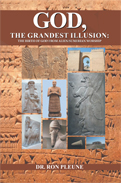
 |
God, The Grandest Illusion: The Birth of God From Alien/Sumerian Worship
by Dr. Ron Pleune
Twenty20 Literary Group
From the onset, the author urges readers to keep an open mind. In order to fully absorb the “Real Truth,” a level of rewiring away from the ingrained beliefs is necessary, and the entire basis of Pleune’s work provides a thought-provoking premise that helps audiences do just that. In this work, the author is determined and unafraid to ruffle feathers, standing steadfast in his desire to present to humanity a complete picture, be it a positive or negative outcome. Throughout, a constant juxtaposition exists between Swiss Billy Meier and the Plejaren, an alien race that Meier is able to communicate with, and the chronology of Earth’s history that dissects religion, debunks the existence of the Godhead, and surmises that God is simply a supremely technologically-advanced extraterrestrial dating back to ancient Sumeria.
Pleune notes that Christianity, and by default, its followers, turn a deaf ear to the overwhelming abundance of evidence that points to alien life and, specifically, the repeated sightings and interactions with UFOs. Using evangelist Billy Graham and Pope Francis himself, the author describes the implications of leaders blindly following “the Law of Rightness” to create and maintain a certain level of hierarchy within religion. Down to the core, Pleune argues that the Bible was transcribed through a form of mental telepathy, a text that, however subtle, inevitably comes from the point of view of the scribe. In other words, it is not immune to the well-known phenomena of human error and bias.
As the work progresses, Pleune cites communication between members of the Plejaren—chiefly one named Ptaah—and Billy Meier, as documented in the "Contact Report." Among other statements, audiences will undoubtedly be intrigued by Ptaah’s comment that the Plejaren have been present on earth for 389,000 years, settling in various regions and even having families with the human race. In fact, the "Chronology of Earth" goes deep into the planet’s monumental moments and inventions and demonstrates the role that extraterrestrials played, even in something as grand as the Great Pyramids. The work ties together the origins of the Hebrews, Jehovah, and ultimately, the notion that humanity was forced into “cultic religion confusion.”
At all times, the complexities of Pleuene’s work are delivered with force and clarity, making it simple for the layman to understand the events, but more importantly, the root of why one would worship God. While the author acknowledges that the majority of humans are simply trying to get through their days, he emphasizes that one should give Meier’s website a chance to see the depths of understanding that could be acquired from it. As Pleune himself has communicated with UFOs, even acknowledging that they have flown within 200 feet of him, he finds a seamless way to weave his analysis of history and the existence of UFOs through art. Whether it is the “disk-shaped object shining beams” during the baptism of Christ or the two saucers depicted in a fresco of Christ’s crucifixion, the mounting evidence provides reasonable doubt for the curious mind to explore the "Goblet of Truth" and focus more on creation rather than God.
On a simple level, Pleune examines God in the context of prayer and faith, citing some of history’s most recent atrocities like 9/11 to question why the multitude of prayers to be saved went unanswered. Undoubtedly, Pleune’s work packs a punch, one that presents both his frame of thinking as well as the catalyst that prompts him to think as he does with complete authenticity for the reader to interpret as he will.